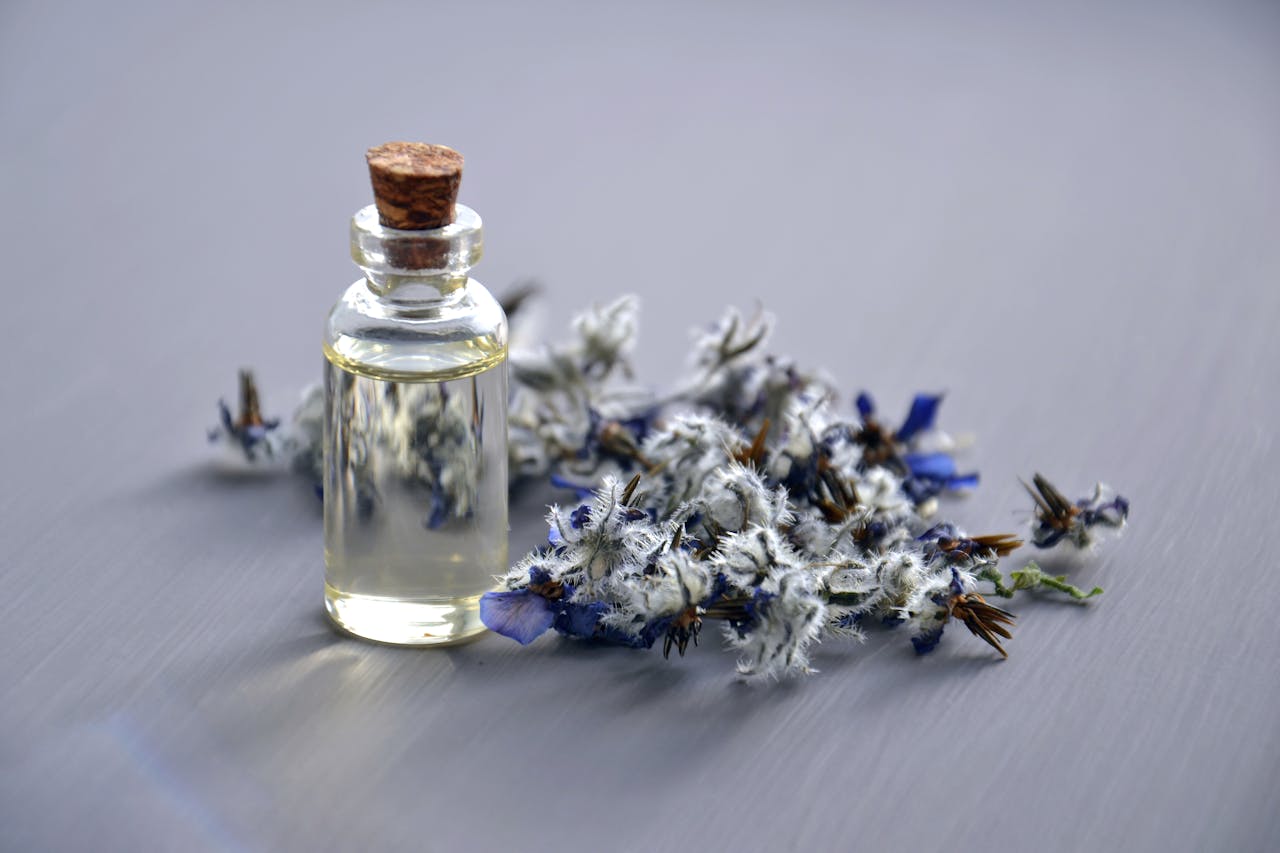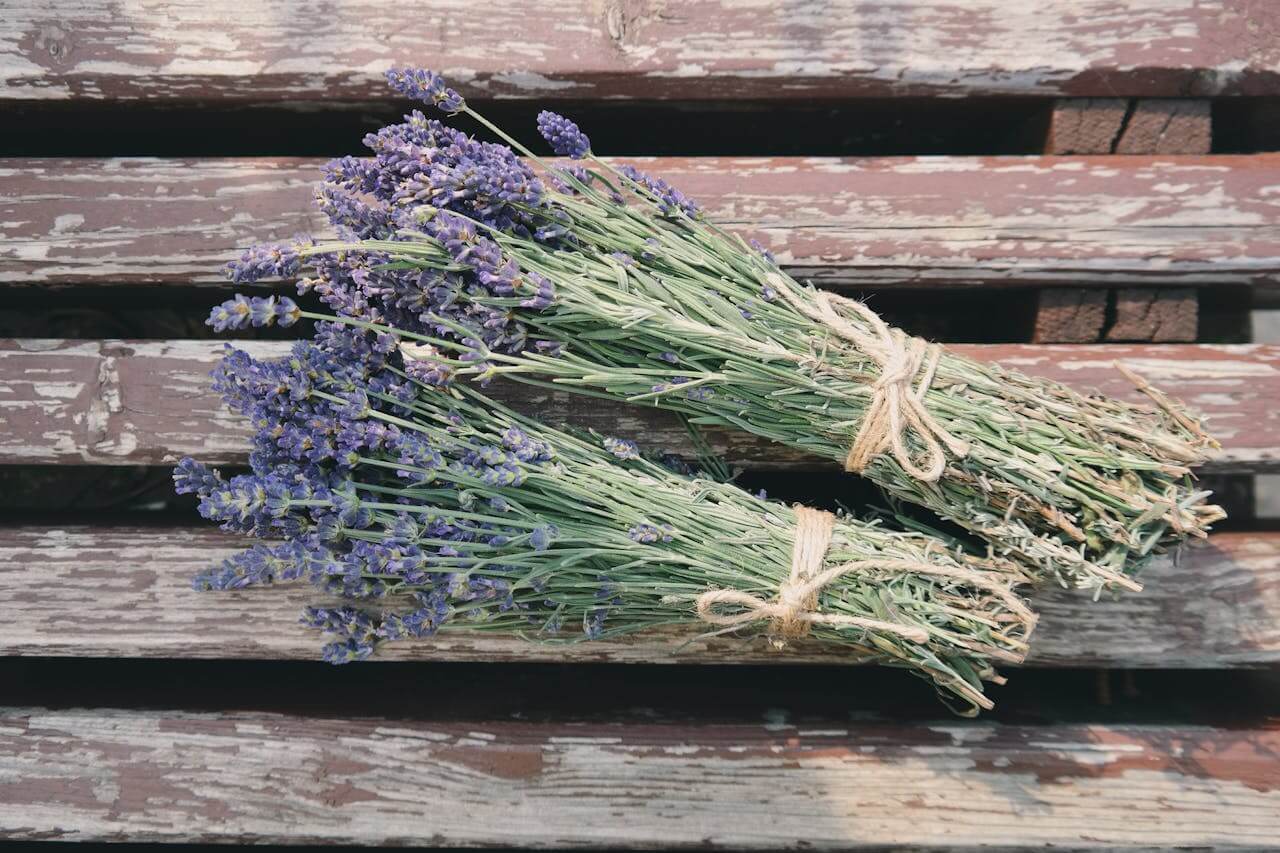Lavender essential oil and dried lavender offer a wealth of uses around the house. Lavender oil – one of Britain’s most beloved herbs – is renowned for its antiseptic and germ-killing properties, can be a natural cleaner, disinfectant spray, and air freshener. Just mix it with vodka, water, or vinegar for versatile cleaning solutions. You can scent rooms by dabbing it on lightbulbs or radiators, and it makes a soothing addition to bath salts and massage oils. It can even relieve congestion when used as a steam inhalation. Dried lavender, on the other hand, naturally scents homes and repels insects. Use it in potpourri, lavender bags for linens, or even lavender bottles to keep clothes and cupboards fresh. Its lovely scent and insect-repelling properties make it a favourite for laundry and storage. Both forms of lavender provide a natural, pleasant way to maintain a clean and calming home environment.

How Can You Take Advantage of Lavender Essential Oil?
So, how do you use lavender essential oil? It may become part of your daily routine and during house cleaning.
Make disinfectant spray
Mix equal proportions of vodka and water, or two units of white vinegar to one unit of water, in a spray bottle. Add about 10–20 drops of lavender essential oil. Shake well. This mixture can also be used to clean glass and as a general disinfectant.
Make air freshener
Put 10–20 drops of essential oil in water in a spray bottle or the same amount of lavender essential oil in a 50/50 mix of water and white vinegar. Shake well before use to disperse the oils. You can also use the disinfectant mixture as an air freshener.
Scent your rooms
Dab a little lavender oil on a cold lightbulb before switching on, or rub a little onto a radiator. When the lightbulb or radiator heats up, the lavender oil will be released and dispersed throughout the room. Alternatively, use an aromatherapy burner of the type heated by a tea light candle.
Scented stationery
Put a few drops of lavender oil on a bit of tissue paper. Tuck the tissue paper into writing paper, scrapbooks, journals, etc.
Bath salts
Take about a cup of common table salt of any type and put it in a screw-top jar. Add 20 drops of lavender oil. Shake well so the smell is dispersed through the salt. Leave it to mellow for a bit before using. If you want, you can tint the salt a delicate purple by mixing a few drops of food colouring into the salt.
As a massage oil
Mix about ten drops of lavender essential oil in a cup of light oil (sunflower oil is good, but olive oil is a bit too strong, although it’s lovely for the skin). Leave it to mellow together for a week or so before use. This oil can also be used as a bath oil.
In the bath
Put ten or more drops of lavender oil into the bath while it’s running. Lavender oil is very calming and soothing—one of the reasons it is prized in aromatherapy—so it is the perfect way to unwind after a hectic day.
As a steam inhalation
Fill a bowl with boiling water and add five drops of lavender oil. Cover the bowl and your head with a towel in a tent. Stay under this tent (don’t touch the water) for at least five minutes, breathing deeply. This is great for relieving congestion and headaches caused by a nasty cold.
Making liquid lavender soap
Get an ordinary bar of soap and chop it up into rough cubes. Put this into a container. Pour about a pint of boiling water over the soap. Leave the soap to melt and then re-congeal into goo. Add 20 drops of lavender essential oil and decant the goo into an airtight container. Use this for washing delicates (the lavender scent is perfect for woollens and repels moths) or handwashing. You can use it to clean nearly anything, including the floor and the car!
Ironing spray
Fill a spray bottle with plain water and add 10 drops of lavender oil. Spray your shirts, etc., with this before ironing them. It makes the chore of ironing a pleasure!
If you are more ambitious, you can also use lavender essential oil to make perfumes, cosmetics, or other handcrafts, such as soap and candles.

How To Employ Dried Lavender To Improve Your Home?
The dried flowers of the scented English lavenders can be used in multiple ways around the home to keep it naturally scented and fresh. Besides the clean, sweet-sharp, slightly old-fashioned scent of lavender, all those toxic artificial thingummies seem pretty pathetic.
Aromatise Laundry
Dried lavender and the scent of lavender have long been associated with linen cupboards and laundry. This is because lavender contains a natural insect repellent that helps keep moths and other unwanted lodgers at bay, such as ants and silverfish (and probably cockroaches, at least to some extent). Lavender smells much nicer on clothes than mothballs by a long chalk. It may also be used in the vacuum cleaner to prevent the foul smell of dust when domestic cleaning.
Most people associate dried lavender flowers in the home with dried flower arrangements and potpourri. The old-fashioned potpourri bowl is best if you want it for the scent rather than the looks. Stirring the dried flower heads of the lavender releases the scent. If the lavender gets a bit old and tired and loses its scent, replace it with fresh lavender or add a few drops of lavender essential oil to recharge the scent.
How To Use Lavender Bags
Lavender bags are another traditional way of keeping your linens (and all your other clothes) smelling fresh and keeping insects away. This allows the scent of lavender to get into the clothing in your drawer, but the dried flower heads don’t break off, leaving you with itchy dried bits in your knickers. You can buy ready-made lavender bags at gift shops and the like. These are usually made from delicate floral cotton lawns and trimmed with lace and ribbon, but this fabric choice doesn’t affect the scent. A hanky tied shut with a rubber band or a bit of string does just as good a job, and there’s no rule engraved in stone saying that you can’t make a lavender bag out of camo-print tied shut with thin rope (now there’s an unexploited market niche…). Putting some lavender bags in your wardrobe will make your room smell fresh and like it’s just been cleaned by your house cleaner.
A lavender bag can be used as a bath bag. Drop one in your bath. This can only be used once or twice. If you want to make a larger lavender bag, you can use it as a cushion. The scent will be released when it is sat on.
Bunches of dried lavender kept in one piece by bits of string or ribbon are best kept for sheets and pillowcases, as these get shaken out before use, so the problem of little bits getting stuck and itching you is less of a problem. Tuck these bunches of lavender into piles of sheets regularly and move them periodically as the sheets get used. Make sure the lavender is dried before you put it into the sheets – dry stuff might go off, or get odd smears on your best white Egyptian cotton.
Lavender bottles are a fancier variation on the bunches with slightly less likelihood of shedding bits. To make a lavender bottle:
- Get a bunch of fresh lavender and tie them tightly together just below the flower head.
- Bend the stalks down so they enclose the flowers in a cage.
- Tie the stems down below the flower head just below where you tied them at first, and then tie them together again at the ends.
It looks like a very long-necked bottle, hence the name.
Lavender bunches and bottles can also be kept in kitchen cupboards to deter ants. It’s best to store them in dried goods that won’t get too badly affected by the scent/taste of lavender. A good suggestion that doesn’t leave you with lavender-flavoured salt or beans is to put the bunches on the shelf or in the cupboard between the boxes, containers and bags of dry goods, which should put the ants and silverfish off before they find their way into your flour.

